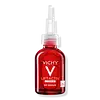What's inside
What's inside
 Key Ingredients
Key Ingredients

 Benefits
Benefits

 Concerns
Concerns

 Ingredients Side-by-side
Ingredients Side-by-side

Water
Skin ConditioningSodium Ascorbyl Phosphate
AntioxidantNiacinamide
SmoothingDimethyl Sulfone
SolventZinc Glycinate
BufferingArbutin
AntioxidantGlutathione
Lepidium Sativum Sprout Extract
Skin ConditioningLactobacillus/Pumpkin Fruit Ferment Filtrate
Skin ConditioningAscorbyl Palmitate
AntioxidantSodium Hyaluronate
HumectantTocopheryl Acetate
AntioxidantLeuconostoc/Radish Root Ferment Filtrate
AntimicrobialGlycerin
HumectantCitrus Limon Fruit Extract
MaskingMaltodextrin
AbsorbentLecithin
EmollientPassiflora Edulis Fruit Extract
Skin ConditioningAnanas Sativus Fruit Extract
Skin ConditioningVitis Vinifera Fruit Extract
Skin ConditioningCarica Papaya Fruit Extract
Skin ConditioningRhodinols
PerfumingInulin
Skin ConditioningAlpha-Glucan Oligosaccharide
CleansingCymbopogon Martini Oil
MaskingAnthemis Nobilis Flower Oil
MaskingRosa Damascena Flower Oil
MaskingLinoleic Acid
CleansingCinnamomum Camphora Linalooliferum Wood Oil
PerfumingSaccharomyces/Magnesium Ferment
Pelargonium Graveolens Oil
MaskingSaccharomyces/Copper Ferment
Skin ConditioningSaccharomyces/Silicon Ferment
Skin ConditioningSaccharomyces/Zinc Ferment
Skin ConditioningSaccharomyces/Iron Ferment
Skin ConditioningJojoba Esters
EmollientJuniperus Mexicana Wood Oil
PerfumingEugenia Caryophyllus Bud Oil
MaskingPhenethyl Alcohol
MaskingPotassium Sorbate
PreservativeEthylhexylglycerin
Skin ConditioningSodium Bisulfite
AntioxidantDisodium EDTA
Alcohol
AntimicrobialAlcohol Denat.
AntimicrobialPhenoxyethanol
PreservativeCitronellol
PerfumingGeraniol
PerfumingLinalool
PerfumingEugenol
PerfumingCI 77491
Cosmetic ColorantWater, Sodium Ascorbyl Phosphate, Niacinamide, Dimethyl Sulfone, Zinc Glycinate, Arbutin, Glutathione, Lepidium Sativum Sprout Extract, Lactobacillus/Pumpkin Fruit Ferment Filtrate, Ascorbyl Palmitate, Sodium Hyaluronate, Tocopheryl Acetate, Leuconostoc/Radish Root Ferment Filtrate, Glycerin, Citrus Limon Fruit Extract, Maltodextrin, Lecithin, Passiflora Edulis Fruit Extract, Ananas Sativus Fruit Extract, Vitis Vinifera Fruit Extract, Carica Papaya Fruit Extract, Rhodinols, Inulin, Alpha-Glucan Oligosaccharide, Cymbopogon Martini Oil, Anthemis Nobilis Flower Oil, Rosa Damascena Flower Oil, Linoleic Acid, Cinnamomum Camphora Linalooliferum Wood Oil, Saccharomyces/Magnesium Ferment, Pelargonium Graveolens Oil, Saccharomyces/Copper Ferment, Saccharomyces/Silicon Ferment, Saccharomyces/Zinc Ferment, Saccharomyces/Iron Ferment, Jojoba Esters, Juniperus Mexicana Wood Oil, Eugenia Caryophyllus Bud Oil, Phenethyl Alcohol, Potassium Sorbate, Ethylhexylglycerin, Sodium Bisulfite, Disodium EDTA, Alcohol, Alcohol Denat., Phenoxyethanol, Citronellol, Geraniol, Linalool, Eugenol, CI 77491
Water
Skin ConditioningButylene Glycol
HumectantNiacinamide
SmoothingHydroxyethylpiperazine Ethane Sulfonic Acid
BufferingGlycerin
HumectantHydroxyethyl Urea
HumectantPropylene Glycol
HumectantGlycolic Acid
BufferingTranexamic Acid
AstringentAllantoin
Skin ConditioningSodium Hydroxide
BufferingPhenoxyethanol
PreservativeChlorphenesin
AntimicrobialAscorbyl Glucoside
AntioxidantCaprylyl Glycol
EmollientHydrolyzed Rice Protein
Skin ConditioningVitreoscilla Ferment
Skin ConditioningTrisodium Ethylenediamine Disuccinate
Xanthan Gum
EmulsifyingPentylene Glycol
Skin ConditioningWater, Butylene Glycol, Niacinamide, Hydroxyethylpiperazine Ethane Sulfonic Acid, Glycerin, Hydroxyethyl Urea, Propylene Glycol, Glycolic Acid, Tranexamic Acid, Allantoin, Sodium Hydroxide, Phenoxyethanol, Chlorphenesin, Ascorbyl Glucoside, Caprylyl Glycol, Hydrolyzed Rice Protein, Vitreoscilla Ferment, Trisodium Ethylenediamine Disuccinate, Xanthan Gum, Pentylene Glycol
 Reviews
Reviews

Ingredients Explained
These ingredients are found in both products.
Ingredients higher up in an ingredient list are typically present in a larger amount.
Glycerin is already naturally found in your skin. It helps moisturize and protect your skin.
A study from 2016 found glycerin to be more effective as a humectant than AHAs and hyaluronic acid.
As a humectant, it helps the skin stay hydrated by pulling moisture to your skin. The low molecular weight of glycerin allows it to pull moisture into the deeper layers of your skin.
Hydrated skin improves your skin barrier; Your skin barrier helps protect against irritants and bacteria.
Glycerin has also been found to have antimicrobial and antiviral properties. Due to these properties, glycerin is often used in wound and burn treatments.
In cosmetics, glycerin is usually derived from plants such as soybean or palm. However, it can also be sourced from animals, such as tallow or animal fat.
This ingredient is organic, colorless, odorless, and non-toxic.
Glycerin is the name for this ingredient in American English. British English uses Glycerol/Glycerine.
Learn more about GlycerinNiacinamide is a multitasking form of vitamin B3 that strengthens the skin barrier, reduces pores and dark spots, regulates oil, and improves signs of aging.
And the best part? It's gentle and well-tolerated by most skin types, including sensitive and reactive skin.
You might have heard of "niacin flush", or the reddening of skin that causes itchiness. Niacinamide has not been found to cause this.
In very rare cases, some individuals may not be able to tolerate niacinamide at all or experience an allergic reaction to it.
If you are experiencing flaking, irritation, and dryness with this ingredient, be sure to double check all your products as this ingredient can be found in all categories of skincare.
When incorporating niacinamide into your routine, look out for concentration amounts. Typically, 5% niacinamide provides benefits such as fading dark spots. However, if you have sensitive skin, it is better to begin with a smaller concentration.
When you apply niacinamide to your skin, your body converts it into nicotinamide adenine dinucleotide (NAD). NAD is an essential coenzyme that is already found in your cells as "fuel" and powers countless biological processes.
In your skin, NAD helps repair cell damage, produce new healthy cells, support collagen production, strengthen the skin barrier, and fight environmental stressors (like UV and pollution).
Our natural NAD levels start to decline with age, leading to slower skin repair, visible aging, and a weaker skin barrier. By providing your skin niacinamide, you're recharging your skin's NAD levels. This leads to stronger, healthier, and younger looking skin.
Another name for vitamin B3 is nicotinamide. This vitamin is water-soluble and our bodies don't store it. We obtain Vitamin B3 from either food or skincare. Meat, fish, wheat, yeast, and leafy greens contain vitamin B3.
The type of niacinamide used in skincare is synthetically created.
Learn more about NiacinamidePhenoxyethanol is a preservative that has germicide, antimicrobial, and aromatic properties. Studies show that phenoxyethanol can prevent microbial growth. By itself, it has a scent that is similar to that of a rose.
It's often used in formulations along with Caprylyl Glycol to preserve the shelf life of products.
Water. It's the most common cosmetic ingredient of all. You'll usually see it at the top of ingredient lists, meaning that it makes up the largest part of the product.
So why is it so popular? Water most often acts as a solvent - this means that it helps dissolve other ingredients into the formulation.
You'll also recognize water as that liquid we all need to stay alive. If you see this, drink a glass of water. Stay hydrated!
Learn more about Water